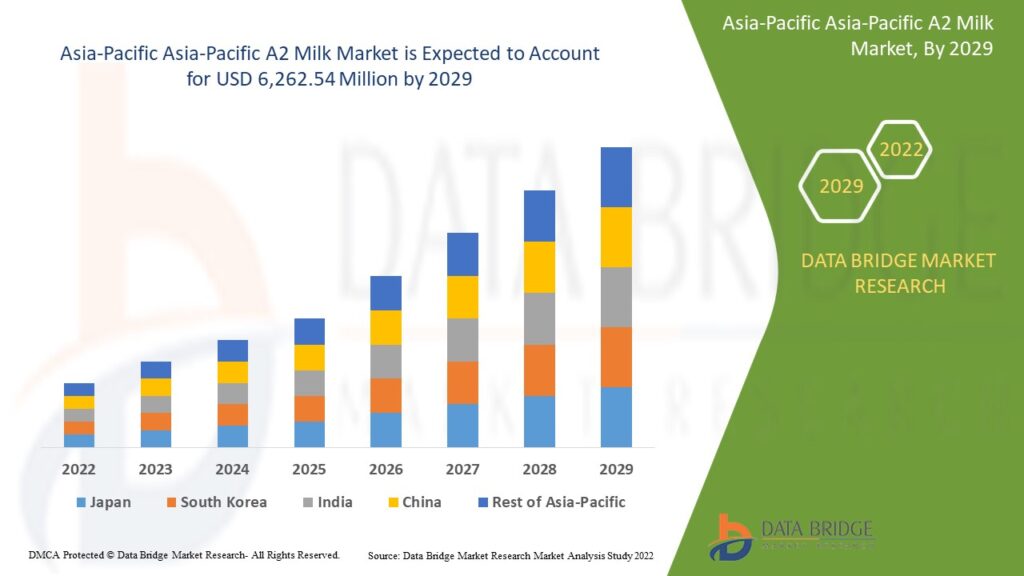The global market for A2 milk has grown significantly in recent years, with increasing demand from consumers who are seeking out healthier and more natural food options.
This growth has been driven by a number of factors, including the growing awareness of the potential health benefits of A2 milk, as well as the increasing availability of A2 milk products in the global marketplace.

Source- databridgemarketresearch.com
Overall Scope (Globally)
In terms of regional developments, the A2 milk market is particularly strong in Australia, where the majority of milk produced is A2 milk.
Australia is also the largest exporter of A2 milk, with significant exports to China and other Asian countries.
In North America, the A2 milk market is also growing, with increasing numbers of consumers seeking out A2 milk products.
Need > Health Benefits
People always look forward to the search for healthy foods and that is where healthy foods like A2 milk are required to fulfil nutritional needs.
A2 milk is a type of cow’s milk that contains only the A2 type of beta-casein protein, as opposed to the A1 and A2 proteins found in most cow’s milk.
This type of milk has gained popularity in recent years due to claims that it is easier to digest and may have health benefits compared to regular cow’s milk.
Participation
One of the key drivers of growth in the A2 milk market is the increasing participation of major milk producers and retailers in the A2 milk space.
Many of the world’s leading milk producers and retailers, including Fonterra, Nestle, and Danone, now offer A2 milk products as part of their product lines. This has helped to increase the availability of A2 milk products and make them more accessible to consumers.
What is the value of the A2 Milk market?
- Fulfilment of Requirement
- Profitable
- Cost Effective
- Easy Available
- Low Cost Labour
- Quantity Availability
- Worthy Byproducts
- Economic Growth
- The fulfilment of A2 milk requirements depends on several factors, including consumer demand, production capacity, and availability of the necessary resources (such as cows and feed).
- A2 milk can be profitable for several reasons, including cost-effectiveness, easy availability, low-cost labour, and the availability of a large quantity. Additionally, the byproducts of A2 milk (such as cheese and yoghurt) can also be sold for a profit.
- Economic growth refers to an increase in a country’s economic output or productivity. It is typically measured by the growth of a country’s gross domestic product (GDP) over time. Economic growth can be driven by various factors, including technological innovation, increases in labour productivity, and growth in domestic or foreign demand for goods and services.
A2 milk is Helpful in growing the industry
Local Vendors:
Due to the increasing demand of A2 milk globally many local vendors will look forward to starting the business in it.
Demands of other milk byproducts:
People are also enjoying the other byproducts of milk which is eventually increasing the demand of A2 milk.
Forecast
Looking ahead, the global A2 milk market is expected to continue to grow, driven by the increasing demand for healthier and more natural food options. This growth presents significant opportunities for companies involved in the production and distribution of A2 milk products, as well as for investors looking to capitalise on the growing demand for these products.
The Dynamics of the Asia-Pacific A2 Milk Market

Source: databridgemarketresearch.com
Drivers-
The Asia-Pacific A2 milk market is driven by a number of factors, including increasing awareness about the health benefits of A2 milk, the growing demand for milk and milk products in the region, and the expansion of distribution channels for A2 milk.
Additionally, the increasing popularity of organic and natural products, as well as the rise in disposable incomes in the region, are also contributing to the growth of the A2 milk market in Asia-Pacific.
Advantages-
The main advantage of A2 milk is that it is easy to digest. Unlike regular cow’s milk, A2 milk only contains the A2 beta-casein protein, which is easily broken down by the human digestive system.
Another advantage of A2 milk is that it is a natural and healthy option for consumers.
A2 milk is produced from cows with A2-A2 genetics who are fed a natural diet and are never given antibiotics or synthetic growth hormones.
This means that A2 milk is free from harmful additives and is a more natural and healthy option for consumers.
Opportunities-
One of the main opportunities for the Asia-Pacific A2 milk market is the increasing demand for healthy and natural food options.
As consumers become more health-conscious and aware of the ingredients in their food, they are increasingly seeking out natural and healthy options, such as A2 milk.
This presents a significant opportunity for A2 milk producers to capitalise on the growing demand for healthy and natural food options.
Another possibility for the A2 milk industry is the increasing utilisation of A2 milk in newborn nutrition and among pregnant women.
As mentioned earlier, A2 milk is easy to digest and is similar to the protein found in breast milk, making it a popular choice for infant formulae.
This presents an opportunity for A2 milk producers to expand into the infant formula market and capitalise on the growing demand for A2 milk in this segment.
Restraints-
One of the main restraints for the Asia-Pacific A2 milk market is the high cost of production.
A2 milk is typically more expensive to produce than regular cow’s milk, as it requires a specialised process and cows that are fed a natural, plant-based diet.
This high cost of production can make A2 milk more expensive for consumers, which may hinder its adoption and limit the growth of the Asia-Pacific A2 milk market.
Another restraint for the Asia-Pacific A2 milk market is the lack of awareness about A2 milk among consumers.
Many people are still unaware of the benefits of A2 milk and the differences between A2 milk and regular cow’s milk.
This lack of awareness can make it difficult for A2 milk producers to market their products and convince consumers to switch to A2 milk.
Challenges-
One of the main challenges for the Asia-Pacific A2 milk market is the presence of strong competition from regular cow’s milk.
Regular cow’s milk is a well-established and widely consumed product, and it is often cheaper and more readily available than A2 milk.
This makes it difficult for A2 milk producers to compete with regular cow’s milk and gain a significant share of the market.
Another challenge for the Asia-Pacific A2 milk market is the lack of regulatory standards for A2 milk.
Currently, there are no official regulatory standards for A2 milk, which makes it difficult for consumers to know if the A2 milk they are purchasing is of high quality.
Because of the lack of regulatory requirements, the Asia-Pacific A2 milk industry may struggle to develop.




